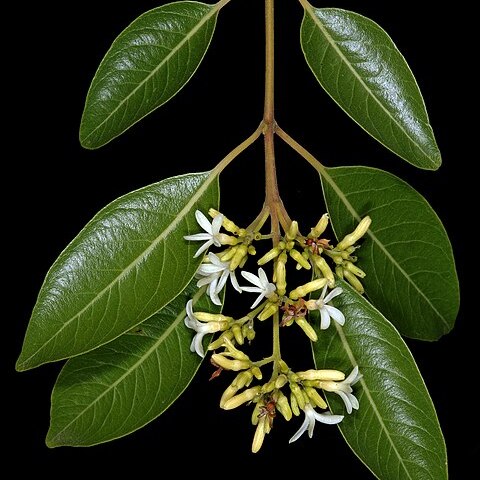Leaves petiolate; petiole (0·5)1-2(3·7) cm., glabrescent to puberulent, above sometimes tomentose, and there with or without a scale-like colleter and/or 1–4 rows of 1–4 smaller glands; lamina variable in shape, obovate, elliptic, subcircular or ovate, (1·1)1·5-2·4(3·2) times as long as wide, (2·6)3·8-9·3(12·l) x (l·1)2·2–5·4(6·7) cm., acute, rounded to emarginate and acuminate to mucronate at the apex, cuneate to obtuse at the base, flat to undulate or sometimes somewhat crispate, thinly coriaceous to leathery, glabrous to pubescent, sometimes only puberulent on the margins, costa puberulent (sometimes the basal part only), rarely glabrous; secondary veins (6)8–14(19) pairs, conspicuous, glabrous or somewhat puberulent, sometimes with axillary tufts of glandular hairs; tertiary veins inconspicuous.
Corolla white to creamy, very rarely reddish to orange, tube (1·5)2–5(7) times as long as the calyx, (1·5)2–3(3·2) x 1–1·5(1·8) mm., glabrous to slightly puberulent outside, lobes (3·5)5(6) x (0·7)1·2(2) mm..rounded or slightly acute, entire, glabrous to puberulent outside, usually with many glandular hairs; buds tinged red; with a scale between the bases of all lobes (scale glabrous, (0·5)0·7–1 (1·2) mm. long, and sometimes at the base with some long scabrid hairs, and connected by its edges with the lobes).
A tree or shrub. It can have one or many stems. It grows 3-12 m high. The trunk can be 50 cm across. The bark is rough and deeply cracked. The small branches droop. The leaves are opposite and yellowish green. The leaf blade varies in shape. It can be 4-9 cm long by 2-5 cm wide. The flowers are white or cream and in loose clusters near the ends of branches. They have a sweet scent. The flowers have a sweet scent. The fruit is made up of 2 follicles. They are woody and boat shaped.
Sepals pale green or yellow-green, sometimes slightly unequal, (0·5)1–2(3) times as long as wide, (0·5)0·75–1(1·5) x (0·25)0·5(0·75) mm., outside pubescent to tomentose at the base, pubescent to glabrous towards the apex, very rarely entirely glabrous, glabrous to appressed-puberulent inside especially towards the apex; margins entire, usually hyaline, scabrid to hirsute, rarely glabrous; receptacle pubescent to tomentose, rarely glabrous to puberulent, with glandular hairs.
Pistil (1·2)1·7–2·2(2·4) mm. long; ovary (0·3)0·4(0·5) x (0·3)0·5(0·8) x (0·5)0·8(1·0) mm., of two carpels, rounded at the apex, glabrous or slightly puberulous; style subapical, filiform, (0·5)0·7–1·3 x 0·2–0·3 mm., not split at the base, glabrous to very slightly puberulous; clavuncula lanuginose, sometimes glabrescent towards the base, (0·2)0·3–0·4 x 0·3–0·4 mm.; apiculum bifid, (0·2)0·3–0·4(0·7) mm. long, glabrous.
Fruit composed of two follicles, which are diverging by 180°, woody, green or pale to dark brown, 1·8–3·3(4·2) times as long as wide, (2·2)2·9–6·6 x 1·1–2·2 x 0·4–1·1(1·8) cm., coherent at the base, obliquely oblong, glabrous or slightly puberulent, 2-valved, each valve 2-seeded.
Small tree or shrub, up to 7 m high. Branchlets minutely greyish tomentose when young, eventually glabrescent. Fruit of 2 mericarps, follicular, spreading widely at ± 180°; leathery to woody with lenticels. Flowers white to yellow.
Trunk 0·10–0·50(2·0) m. in diam.; bark smooth to rough, usually longitudinally fissured or reticulate, greyish, brownish to blackish; wood whitish yellow to pale orange.
Seed (2·5)3·5–4·5(5·5) cm. long; grain dark brown, elliptic, (1)1·3–2·0 x 0·7–1·2(1·8) cm., wing diaphanous, with longitudinal veins, 2·0–2·5(3·2) x 1–1·5(1·9) cm.
Stamens with the filaments usually scabrid to hispid, rarely glabrous, 0·2–0·5(0·8) mm. long; anthers 1–1·2(1·5) x 0·5 mm., with a 0·1–0·2(0·5) mm. long mucro.
Inflorescence (1·5)2–9(14) x (2)2·5–9(13) cm.; bracts obscure, rounded, glabrous to pubescent, sometimes with glandular hairs.
Pedicels glabrous to tomentose, sometimes with glandular hairs, 0·5–2·5(3·0) mm. long.
A tree or shrub, sometimes scandent, 1–many-stemmed, (1)3–12(20) m. tall.
Branchlets drooping, puberulent to glabrous.
Peduncle 0·6–4(4·5) cm. long.
Flowers very sweet-scented.



